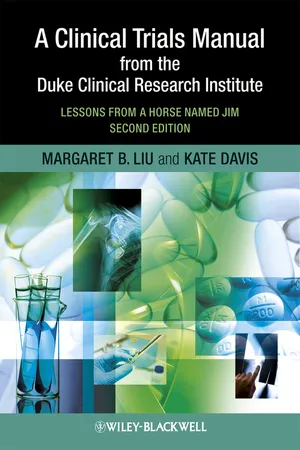
A Clinical Trials Manual From The Duke Clinical Research Institute
Lessons from a Horse Named Jim
- English
- ePUB (mobile friendly)
- Available on iOS & Android
A Clinical Trials Manual From The Duke Clinical Research Institute
Lessons from a Horse Named Jim
About this book
"The publication of the second edition of this manual comes at an important juncture in the history of clinical research. As advances in information technology make it possible to link individuals and groups in diverse locations in jointly seeking the answers to pressing global health problems, it is critically important to remain vigilant about moral and ethical safeguards for every patient enrolled in a trial. Those who study this manual will be well aware of how to ensure patient safety along with fiscal responsibility, trial efficiency, and research integrity."
— Robert Harrington, Professor of Medicine, Director, Duke Clinical Research Institute, Durham, North Carolina, USA
The Duke Clinical Research Institute (DCRI) is one of the world's leading academic clinical research organizations; its mission is to develop and share knowledge that improves the care of patients around the world through innovative clinical research. This concise handbook provides a practical "nuts and bolts" approach to the process of conducting clinical trials, identifying methods and techniques that can be replicated at other institutions and medical practices.
Designed for investigators, research coordinators, CRO personnel, students, and others who have a desire to learn about clinical trials, this manual begins with an overview of the historical framework of clinical research, and leads the reader through a discussion of safety concerns and resulting regulations. Topics include Good Clinical Practice, informed consent, management of subject safety and data, as well as monitoring and reporting adverse events.
Updated to reflect recent regulatory and clinical developments, the manual reviews the conduct of clinical trials research in an increasingly global context. This new edition has been further expanded to include:
- In-depth information on conducting clinical trials of medical devices and biologics
- The role and responsibilities of Institutional Review Boards, and
- Recent developments regarding subject privacy concerns and regulations.
Ethical documents such as the Belmont Report and the Declaration of Helsinki are reviewed in relation to all aspects of clinical research, with a discussion of how researchers should apply the principles outlined in these important documents. This graphically appealing and eminently readable manual also provides sample forms and worksheets to facilitate data management and regulatory record retention; these can be modified and adapted for use at investigative sites.
Frequently asked questions
- Essential is ideal for learners and professionals who enjoy exploring a wide range of subjects. Access the Essential Library with 800,000+ trusted titles and best-sellers across business, personal growth, and the humanities. Includes unlimited reading time and Standard Read Aloud voice.
- Complete: Perfect for advanced learners and researchers needing full, unrestricted access. Unlock 1.4M+ books across hundreds of subjects, including academic and specialized titles. The Complete Plan also includes advanced features like Premium Read Aloud and Research Assistant.
Please note we cannot support devices running on iOS 13 and Android 7 or earlier. Learn more about using the app.
Information

Table of contents
- Cover
- Series page
- Title page
- Copyright
- Foreword
- Preface
- Abbreviations
- 1: Lessons from a Horse Named Jim and Other Events in History Affecting the Regulation of Clinical Research
- 2: The Process: Developing New Drugs, Biologics, and Devices
- 3: Good Clinical Practice and the Regulations
- 4: Informed Consent and the Regulations
- 5: Institutional Review Boards
- 6: Adverse Events and Unanticipated Problems Involving Risks to Subjects or Others
- 7: Monitoring, Audits, and Inspections
- 8: The Principal Investigator, the Clinical Research Coordinator, and the Study Site
- 9: The Protocol
- 10: Study Feasibility: Reviewing a Specific Protocol
- 11: Study Activities
- 12: Study Documents/Essential Documents
- 13: Management of Study Drugs, Biologics, and Devices
- 14: Managing Clinical Trial Data
- 15: Global Health and International Trials
- Appendix A
- Appendix B
- Appendix C
- Appendix D
- Appendix E
- Epilogue
- Glossary
- Index